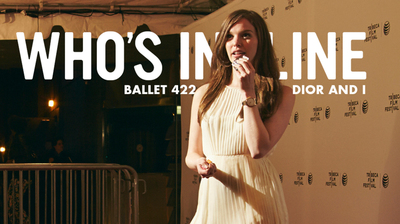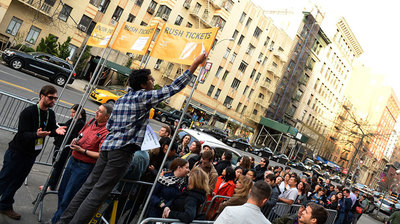
BY KAREN KEMMERLE |
Andrew Disney on ‘Intramural,’ Test Audiences And Why Film School Matters
We talk to director Andrew Disney about his uproarious sports comedy, 'Intramural,' starring Jake Lacy, Nikki Reed, and 'SNL’s Kate McKinnon and Jay Pharaoh.

Take the heart of Rocky, the training montage of Dodgeball, the offbeat characters of the college classic PCU, and the camera work of Any Given Sunday, and you’ve got Intramural. Directed by Andrew Disney and written by Bradley Jackson, this soon-to-be sports comedy classic is a hilarious homage to one cinema’s most beloved genres—the inspirational sports movie.
Intramural football star Caleb Fuller (The Office’s Jake Lacy) quits the team after his best friend/teammate Grant suffers a devastating injury. Dissatisfied with his 5th year “victory lap” and insane fiancee (SNL’s Kate McKinnon), Caleb returns to the team, seeking redemption and the chance to help his teammates defeat their nemesis and take back the title.
We spoke to director Andrew Disney about the film, early influences and the only cure for the dreaded “director’s disease.”
Tribeca: You’re originally from Texas but you went to film school at NYU. Why did you decide to go to school on the east coast?
Andrew Disney: I really knew I wanted to study film. It was either USC or NYU, but I chose NYU because I thought I would never have the opportunity ever again to live in New York City. It’s just so cool—going to school and living in the city. It’s a different college experience.
Tribeca: Your knowledge of obviously came into play when you were directing Intramural. How vital is it for filmmakers to have a working knowledge of cinema history?
AD: I think it depends on what kind of films you’re making, but it is always important to familiarize yourself with the genre of the film that you’re working on. It is helpful to know what’s come before and what kind of tools people used to make effective movies in the past. I like to look at movies as big machines that are going to take the audience on a ride. You should look back at the ways that other filmmakers built their machines before you work on yours.
Tribeca: Was it important for you to go to film school? Do you think the same knowledge can be gained from watching lots and lots of movies?
AD: There is always that debate between film school filmmakers and self-educated filmmakers. One of great things about film school is that you’re given assignments that have concrete deadlines. I think that’s the hardest thing about being a filmmaker. You have to be a self-starter, and I learned a lot of that from my time at school.
Being in that environment forced me to look at scripts and films analytically, in addition to making my own films post-college. However, I didn’t learn everything in film school. I also learned just by being on film sets and figuring out how films are made. In this day and age with digital tools, there’s no excuse. If you want to make movies, just make movies.
I like to look at movies as big machines that are going to take the audience on a ride.
Tribeca: What was the first movie that really got you interested in making movies?
AD: I remember seeing Indiana Jones and the Last Crusade in theaters when I was like four years old. It’s just ingrained in my mind. I grew up loving Indiana Jones and Star Trek, and I loved films in the 80’s and 90’s that were just fun rides. They probably first got me thinking as a kid, wanting to figure out how people created films that took me to these great places.
Tribeca: More and more, independent movies not made in Brooklyn are being made in Austin. Is Austin the new indie Hollywood? What’s the best thing about making films in Austin?
AD: We shot everything in Austin with the exception of a few scenes. There are so many people there who are filmmakers, and the community was so supportive of us. With Intramural, we would bring new cuts of the film to screen at the Austin Film Society where many talented filmmakers watch with us and give us notes to make the film funnier and funnier.
Plus, there’s just something about Texas and its maverick kind of spirit. Austin filmmakers just keep experimenting and trying to figure out cooler things. It’s a great place to be making movies.
Tribeca: How did Bradley Jackson first approach you with the project? Can you talk about the collaborative process?
AD: Bradley and I had a lot of mutual friends. If you’re in the Texas film scene, you’re going to know everybody. He saw my first film, Searching for Sonny, at the Austin Film Festival. We were at a party when he started telling me about this movie called Intramural that he’d been writing. He gave me the script, and I fell in love with it. It stuck me as a movie I could watch with my friends—it already felt so insanely quotable. I just couldn’t get it out of my head. We gathered up a team of producers at various film festivals and got to work.
Working with Bradley was fun because during filming he’d come up with new lines or he’d help out in the editing room to cut a joke or a comical scene in just the right way.

Tribeca: How much of the dialogue in the film was scripted vs. improvised?
AD: With such a talented cast, every scene has at least one or two hilarious lines that were improvised. We ended up with about 80% of the dialogue being scripted and 20% improv. It was a blast working with comedic actors like Kate McKinnon, Beck Bennett, and Nick Rutherford. I’d tell them “Give me what’s there for the first two takes and then we can play around.” I had this thing called "freebies" when the actors would do their own thing. When they know they have the scene in the can but go on and improvise for the fun of it, that’s when the magic happens.
Tribeca: As we’ve already discussed on our site, you had a very unique casting process. Can you talk about the impetus behind the casting videos? Why do you think they were so effective?
AD: I used casting videos on my first feature, Searching for Sonny. I felt like it was just a great way to get in front of people. Usually the casting director or the agent or the manager are the first ones to see actors, They’re kind of like gatekeepers, so you have to impress them first. It was just a way to do something that was fun and creative and different.
Plus, when the actors all came to Texas, they felt like they already knew us. I just felt touched. I felt like, “Oh wow these guys really, really want to be in the movie” and they wouldn’t have if I didn’t make those videos.
A lot of comedy is killing your darlings.
Tribeca: Among the cast were The Office’s Jake Lacy and SNL’s Kate McKinnon and Jay Pharaoh. Is it intimidating to direct such incredible comedic talents in a comedy movie? Can you discuss your process?
AD: Yeah it’s incredibly intimidating. Before starting a movie, especially this one, I always start feeling nervous and something weird happens. I think the scientific term is “director’s disease.” [laughs] I hurt my back a couple of days before shooting, and I started reading into it and was freaking out. But then I realized it was just nerves. And those nerves went away once the cameras started rolling.
Once I started working with the cast, it was very easy for us to all get into the same mindset. They’re all so great and fun to work with. I think having all these comedians together gave this movie a camp feel. Plus, all the actors were playing sports together. We even had a coach on set. It all felt very much like a summer camp, as cliche as that sounds.
Tribeca: You shot the slow-motion scenes (necessary for any sports movie) with the RED EPIC. Can you talk about that choice and about working with your DP, Jeffrey Waldron? What sort of sports films did you look to for visual references besides Rocky?
AD: We originally wanted to use the Phantom camera, but the money we raised on Kickstarter ended up being used for other things. The RED EPIC was a fine substitution.
Jeff is just an amazing cinematographer. We locked ourselves away for a week and spent twelve hours a day making shot lists for the film. Plus, we had so many great visual references to play with—Rocky and Any Given Sunday especially. We also looked a lot at Hot Rod, a funny and quotable film by the smart guys behind Lonely Island. Every camera movement, every visual joke, the ways they moved the camera—it is all so clever. They used the camera as a performer. That’s what I really love most about Hot Rod.
Tribeca: So much of making comedy is in the pacing. How long wasIntramural in post-production? Can you discuss your collaborative process with editor Kody Gibson?
AD: Kody was just really great to work with. I think, in total, the post-production process took about 4 months. We started with the big cut with all the jokes, and it took a long time to cut it all down. We used test audiences with this film because we wanted to see which jokes worked and which ones didn’t.
Our first cut was 106 minutes, and, after 5 test screenings, we ended up with a cut that was 95 minutes. A lot of comedy is killing your darlings. There’s so many jokes that I thought were really funny or Kody thought were really funny, but if the audiences didn’t laugh at them for two screenings, we cut them.
I think indie films could function without Kickstarter but not with the same kind of heart.
Tribeca: You raised over $50K on Kickstarter to help make Intramural. Could indie films function without crowdfunding nowadays? Do you have any tips for aspiring filmmakers?
AD: I think Kickstarter is as much about spreading the word about your project as it is about money. On every indie film, you always could use more money. You’re always thinking about that Steadicam you could have rented if you raised just a little bit more. You just have to push that out of your mind.
However, you also need to build your fan base, and people who donate to your Kickstarter become your angel fans and investors. They’re the ones who are going to follow your film the most. They’re your family and friends. I think indie films could function without Kickstarter but not with the same kind of heart.
Tribeca: Was there a lesson you learned from Kickstarter that you wanted to share?
AD: I think the biggest mistake filmmakers make on Kickstarter is they don’t designate just one person to be in charge of the campaign. I know I was so worried about making a great film that I didn’t have the time to focus on the campaign. Andrew Lee, one of our producers, ended up handling our Kickstarter, and he just did a fantastic job.
Also, you have to be prepared mentally and emotionally. It is a very hard thing to pull off. You have this euphoria in the beginning when you’re getting all this money, and then there is an inevitable lull, and then frantic contributions come in at the end. It adds a whole new layer of suspense and worry to your life. But, at least for us, it was totally worth it.
Click here to see when Intramural is playing at TFF 2014.

